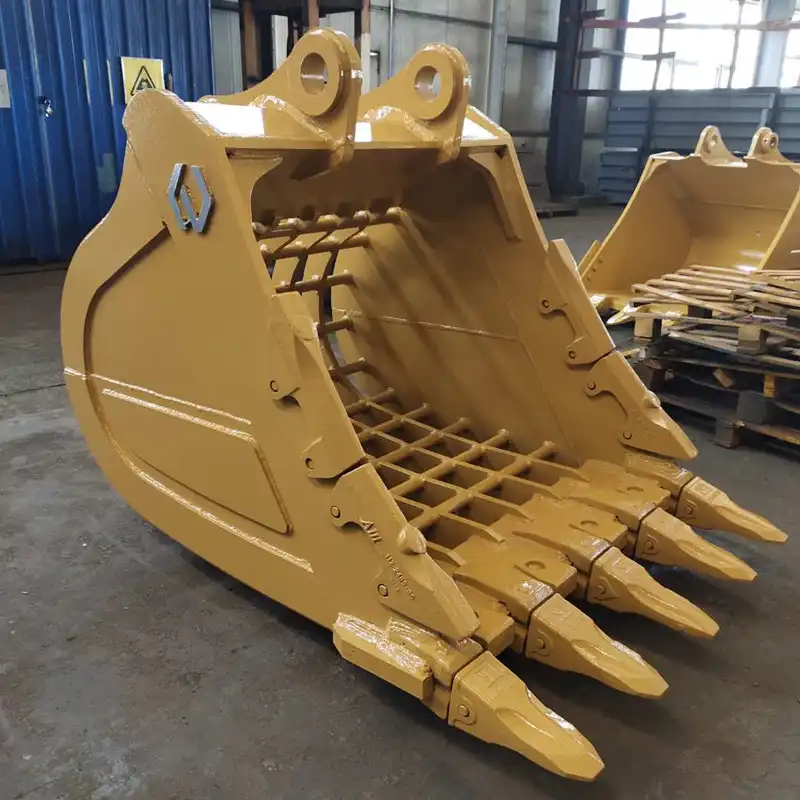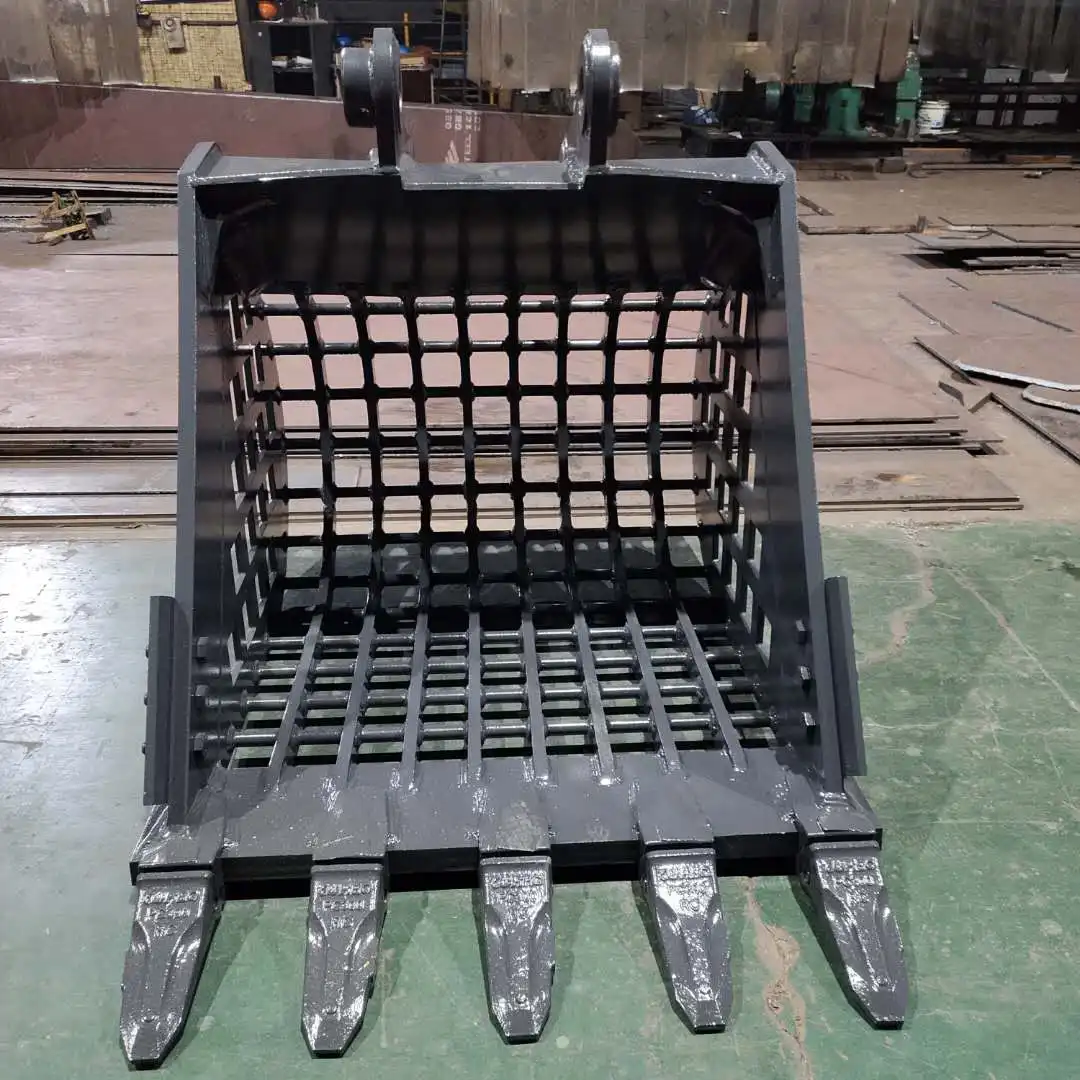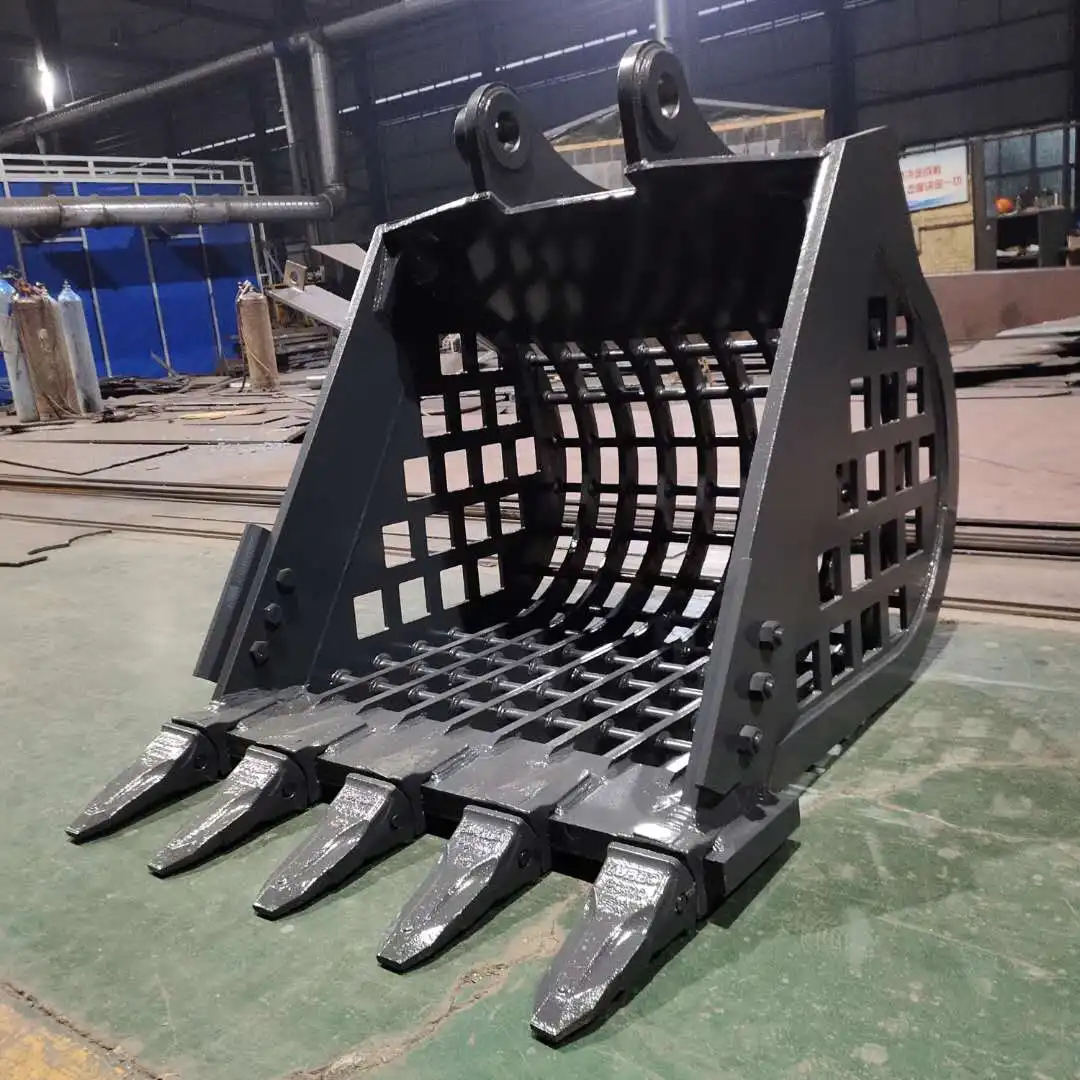Why every quarry needs a heavy-duty excavator grid bucket?
Every quarry needs a heavy-duty excavator grid bucket to boost efficiency and productivity. These specialized attachments revolutionize material handling in quarrying operations. With their unique grid-like design, grid buckets excel at separating rocks from finer materials right at the excavation site. This on-the-spot screening saves time, reduces equipment wear, and streamlines the entire quarrying process. By incorporating a heavy-duty grid bucket into their fleet, quarry operators can significantly improve their output while minimizing operational costs.
Efficient Separation
Precise Material Sorting with Grid Bucket Technology
Grid bucket technology has transformed the way quarries handle material separation. The carefully engineered grid design allows for precise sorting of various sized materials directly at the source. As the excavator scoops up a load, smaller particles fall through the grid openings, while larger rocks remain in the bucket. This instant classification eliminates the need for additional screening equipment and reduces the workload on crushing stations.
The grid spacing can be customized to match specific quarry requirements, ensuring optimal separation for different types of stone and aggregate. Some models even feature adjustable grid sizes, providing flexibility to adapt to changing material compositions or production needs. By implementing this advanced sorting technology, quarries can significantly enhance their material processing capabilities.
Optimizing Workflow: Separating Rocks from Fines
One of the key advantages of using a heavy-duty excavator grid bucket is its ability to separate rocks from fines efficiently. This process optimization has a ripple effect throughout the entire quarry operation. By removing unwanted fines at the extraction point, the amount of material sent to crushers and screeners is reduced, leading to less wear on downstream equipment and lower energy consumption.
Moreover, this early separation allows for better control over the quality of the final product. Quarry managers can ensure that only appropriately sized rocks are processed further, resulting in more consistent output and reduced waste. The ability to sort materials on-site also opens up opportunities for creating multiple product streams simultaneously, increasing the quarry's overall production capacity and market flexibility.
Enhancing Quarry Productivity through Efficient Screening
Efficient screening is at the heart of enhancing quarry productivity, and excavator grid buckets excel in this area. By integrating the screening process into the initial excavation stage, these attachments eliminate the need for separate screening operations. This consolidation of tasks not only saves time but also reduces the amount of equipment and labor required on-site.
The improved material flow resulting from efficient screening leads to smoother operations downstream. Crushers receive pre-screened material, allowing them to operate more effectively and with less downtime. Additionally, the reduction in over-processing of already suitable materials conserves energy and extends the lifespan of processing equipment. As a result, quarries can achieve higher throughput rates and better overall operational efficiency.

Reduces Secondary Crushing
Minimizing Oversize Material: Grid Bucket's Role
Grid buckets play a crucial role in minimizing oversize material reaching secondary crushing stages. By effectively screening out smaller particles during the initial excavation, these buckets ensure that only rocks requiring further processing are sent to crushers. This targeted approach significantly reduces the volume of material needing secondary crushing, leading to substantial energy savings and increased crusher efficiency.
The ability to control the size of material entering the crushing circuit also helps prevent equipment jams and breakdowns. Oversize rocks that might cause issues in standard crushing setups are easily identified and set aside for separate processing or breaking. This proactive management of material size contributes to smoother operations and less downtime for maintenance or clearing blockages.
Cost-Effective Solution: Less Wear on Crushing Equipment
Implementing excavator grid buckets offers a cost-effective solution for quarry operations by significantly reducing wear on crushing equipment. With pre-screened material entering the crushers, there's less stress on the machinery, leading to extended service life and decreased maintenance requirements. This reduction in wear translates directly into lower operational costs and improved equipment reliability.
Furthermore, the decreased volume of material needing processing allows crushers to operate more efficiently, consuming less power per ton of finished product. The combination of reduced equipment wear and lower energy consumption makes grid buckets a smart investment for quarries looking to optimize their operational expenses while maintaining high productivity levels.
Streamlining Operations: From Excavation to Final Product
Heavy-duty excavator grid buckets streamline quarry operations by bridging the gap between excavation and final product creation. By performing initial screening at the point of extraction, these buckets eliminate several intermediate steps in the traditional quarrying process. This streamlined approach not only saves time but also reduces the complexity of material handling and transportation within the quarry.
The simplified material flow allows for more efficient resource allocation, as fewer pieces of equipment and personnel are needed to manage the screening and sorting processes. Quarry managers can focus on optimizing the core extraction and crushing operations, leading to improved overall productivity and faster turnaround times for producing marketable aggregates.

Increases Production Speed
Boosting Throughput: Grid Bucket's Impact on Quarry Efficiency
Grid buckets significantly boost throughput in quarry operations by combining excavation and initial screening into a single step. This integration accelerates the entire production process, allowing quarries to handle larger volumes of material in less time. The immediate separation of usable material from waste or oversized rocks means that downstream processes receive a steady flow of properly sized aggregate, minimizing bottlenecks and idle time.
The increased efficiency provided by grid buckets enables quarries to meet tight production schedules and respond quickly to market demands. By streamlining the initial stages of material processing, these attachments create a more agile production system capable of adapting to varying customer requirements or sudden increases in demand.
Time-Saving Benefits: On-Site Material Classification
On-site material classification offered by excavator grid buckets delivers significant time-saving benefits to quarry operations. By eliminating the need to transport all excavated material to a central screening location, these buckets reduce cycle times and minimize material handling. Operators can quickly assess and sort materials directly at the extraction point, making informed decisions about where each load should be directed.
This immediate classification also allows for more efficient use of transportation resources within the quarry. Trucks can be loaded with pre-screened material, reducing unnecessary movement of fines or waste rock. The time saved through this streamlined process can be reinvested into other aspects of the operation, further enhancing overall productivity.
Maximizing Output: Grid Buckets in High-Volume Operations
In high-volume quarry operations, grid buckets prove invaluable for maximizing output. Their ability to handle large quantities of material while simultaneously performing crucial screening tasks makes them indispensable in meeting demanding production targets. By maintaining a consistent flow of properly sized aggregate to processing plants, these buckets help ensure that crushing and sorting equipment operates at peak efficiency.
The versatility of grid buckets also contributes to increased output in varied conditions. Whether dealing with wet, sticky materials or dry, loose aggregate, these attachments can be adjusted to maintain optimal performance. This adaptability ensures that production speeds remain high regardless of changing material characteristics or weather conditions, providing quarries with reliable and consistent output.
Heavy-duty excavator grid buckets are essential tools for modern quarry operations. They offer unparalleled efficiency in material separation, significantly reduce secondary crushing needs, and boost overall production speed. By integrating these versatile attachments into their equipment fleet, quarry operators can streamline their processes, lower operational costs, and improve product quality. The benefits of grid buckets extend beyond immediate productivity gains, contributing to long-term operational sustainability and competitiveness in the aggregate industry.

FAQ
1. What size grid openings should I choose for my excavator grid bucket?
The ideal grid opening size depends on your specific quarry needs. Typically, sizes range from 50mm to 200mm. Consider the type of material you're excavating and the desired final product size. It's best to consult with a manufacturer to determine the optimal grid size for your operation.
2. Can excavator grid buckets handle wet or sticky materials?
Yes, many modern grid buckets are designed to handle wet or sticky materials. Some models feature self-cleaning mechanisms or specially coated surfaces to prevent material buildup. However, extremely wet conditions may require additional measures or specialized buckets.
4. Are grid buckets suitable for all types of excavators?
While grid buckets can be fitted to many excavator models, it's important to match the bucket to your machine's specifications. Factors like weight capacity, hydraulic flow, and attachment interface need to be considered. Most reputable manufacturers offer grid buckets compatible with a wide range of excavator sizes and makes.
4. How does using a grid bucket affect fuel consumption?
Generally, using a grid bucket can lead to reduced fuel consumption in overall quarry operations. By combining excavation and screening tasks, you eliminate the need for separate screening equipment, potentially saving fuel. Additionally, the reduced load on crushers and other processing equipment can further lower energy requirements.
5. What maintenance is required for excavator grid buckets?
Regular maintenance for grid buckets typically includes inspecting for wear and damage, especially to the grid bars and cutting edges. Lubrication of moving parts, if present, is also important. The frequency of maintenance depends on usage and working conditions. Following the manufacturer's guidelines is crucial for optimal performance and longevity.
China Excavator Grid Bucket Supplier
TianNuo Machinery stands as a leading manufacturer of excavator grid buckets in China. Our product line includes a wide range of excavator accessories and modifications, from standard buckets to specialized attachments for various industries. We pride ourselves on delivering high-quality, durable products that meet the demanding needs of quarrying and construction operations. Our grid buckets are engineered using high-strength wear-resistant steel, ensuring longevity and performance in tough conditions. With customizable options and compatibility with various excavator models, we offer solutions tailored to your specific requirements. For inquiries about our excavator products, contact us at arm@stnd-machinery.com.
References
- Smith, J. (2023). Advanced Excavator Attachments in Modern Quarrying. Journal of Mining Technology, 45(2), 112-128.
- Johnson, R. & Brown, T. (2022). Efficiency Gains in Aggregate Production: A Comprehensive Study. Quarry Management, 18(4), 76-92.
- Davis, M. (2021). Innovative Screening Techniques in Quarry Operations. International Journal of Mineral Processing, 163, 105-120.
- Wilson, E. (2023). Cost-Benefit Analysis of Specialized Excavator Buckets in Mining. Mining Engineering, 75(3), 201-215.
- Thompson, L. (2022). Environmental Impact Reduction Through Advanced Quarrying Equipment. Sustainable Mining Practices, 29(1), 45-60.
- Anderson, K. & Lee, S. (2023). Optimizing Material Handling in High-Volume Quarries. Aggregate Research International, 56(2), 178-193.
About Author: Arm
Arm is a leading expert in the field of specialized construction and railway maintenance equipment, working at Tiannuo Company.

